Research on the Influence of Backfilling Mining in an Iron Mine with Complex Mining Conditions on the Stability of Surface Buildings
Abstract
:1. Introduction
2. Selection of Mining Methods
2.1. Geological Conditions of the Mining Area
2.2. Selection of Mining Methods
3. Estimation of Mechanical Parameters of Rock Mass
3.1. Rock Mechanical Experiments
3.2. Hoek–Brown Parameters
3.3. Mechanical Parameters of Rock Mass
4. Numerical Simulation Analysis of Surface Deformation
4.1. Establishment of Numerical Simulation
4.2. Stress and Displacement Analysis of Ore Body Surrounding Rock
4.3. Numerical Simulation Analysis of Surface Deformation
4.3.1. Calculation Principles and Limits of Surface Deformation
4.3.2. Surface Subsidence
4.3.3. Horizontal Deformation of the Surface
4.3.4. Surface Inclination Characteristics
4.3.5. Surface Curvature Characteristics
5. On-Site Monitoring
6. Conclusions
- (1)
- Based on the engineering geological conditions of the Wuji iron mine, a comprehensive evaluation was conducted of the mining scheme in terms of mining technology, mining safety, economic benefits, and other aspects, and the VCR delayed backfilling method was finally selected for mining.
- (2)
- The stress concentration occurs at the top of the ore body and in some surrounding rocks between the ore veins. This is mainly because the rock mass between the ore veins supports the top surrounding rock, and the direction of the principal stress is consistent with that of the main bearing capacity of the rock mass. Therefore, the surrounding rocks of the hanging walls and footwalls of ore veins should be protected to reduce damage to the surrounding rock caused by blasting during the mining process.
- (3)
- The distribution pattern of surface subsidence obtained from numerical simulation is the same as that obtained by on-site monitoring, which is consistent with that of the ore body (NW trend). After the mining of the ore body is completed, the maximum subsidence area appears in the middle zone of the ore body, followed by the northern zone, and the stress concentration is the smallest in the southernmost zone of the ore body.
- (4)
- The gradual accumulation of deformation in the surrounding rock is the main cause of mining-induced rock deformation in the mining area, ultimately affecting surface deformation. The maximum value of surface settlement in this mining area is 33 cm, which is less than the specified critical value of surface subsidence.
- (5)
- The surface deformation is related to the strike of the ore body, and the surface deformation in the X direction is greater than that in the Y direction of the mining area. The maximum horizontal deformation in the X and Y directions are 1.05 mm/m and 0.47 mm/m, respectively, the maximum curvature in the X and Y directions are 0.02 × 10−3/m and 0.017 × 10−3/m, respectively, and the maximum inclination in the X and Y directions are 1.24 mm/m and 0.76 mm/m, respectively. The above surface deformation values are all smaller than the allowable critical deformation values of buildings and structures specified in the Code for Design of Nonferrous Metal Mining.
- (6)
- This research provides a theoretical basis and engineering guidance for the prevention and control of surface deformation during mining under buildings and structures.
Author Contributions
Funding
Institutional Review Board Statement
Informed Consent Statement
Data Availability Statement
Acknowledgments
Conflicts of Interest
References
- Lian, D.; Wang, Y. Comprehensive evaluation system of “three under” coal mining. J. China Univ. Min. Technol. 2005, 1, 100–104. (In Chinese) [Google Scholar]
- Cheng, L.; Li, X.; Ye, Z.; Sun, X. Surface stability analysis of “three under” mining within subsidence basin in a gold mine. Met. Mine 2019, 3, 56–61. (In Chinese) [Google Scholar]
- Guo, W.; Ma, Z.; Bai, E. Current status and prospect of coal mining technology under buildings, water bodies and railways, and above confined water in China. Coal Sci. Technol. 2020, 48, 16–26. (In Chinese) [Google Scholar]
- Xu, M. Mining Induced Failure Characteristics and Deformation Prediction Method of High-Grade Highway; China University of Mining and Technology: Beijing, China, 2017. [Google Scholar]
- Yi, Z. Research on Safety Technology of “Three Under” Resources Exploitation of Xinqiao Mining; Central South University: Changsha, China, 2008. [Google Scholar]
- Villegas, T.; Nordlund, E.; Dahnér-Lindqvist, C. Hangingwall surface subsidence at the Kiirunavaara Mine, Sweden. Eng. Geol. 2011, 121, 18–27. [Google Scholar] [CrossRef]
- Villegas Barba, T.F.; Nordlund, E. Numerical analyses of the hangingwall failure due to sublevel caving: Study case. Int. J. Min. Miner. Eng. 2013, 4, 201–223. [Google Scholar] [CrossRef]
- Marschalko, M.; Yilmaz, I.; Křístková, V.; Fuka, M.; Bednarik, M.; Kubečka, K. Determination of actual limit angles to the surface and their comparison with the empirical values in the Upper Silesian Basin (Czech Republic). Eng. Geol. 2012, 124, 130–138. [Google Scholar] [CrossRef]
- Jing, W.; Zhang, G. Study on “Three-under” mining techniques in South area of the Xikuangshan mine. Hunan Nonferrous Met. 2003, 6, 1–4. (In Chinese) [Google Scholar]
- Wang, S.; Wang, K.; Ma, F.; Lu, R. Optimization of three-underground mining technology and disaster prevention in Sanshandao gold mine. Gold Sci. Technol. 2020, 28, 734–742. (In Chinese) [Google Scholar]
- Guo, M.; Li, J.; Li, H.; Dongxu, C. Safety impact analysis of “three under” mining for Panlong lead-zinc mine. Nonferrous Met. Eng. 2020, 10, 107–112. (In Chinese) [Google Scholar]
- Wu, Z.; Wang, J.; Liu, P.; Li, Z.; Chen, H. Analysis on the influence of security pillar mining on surface structures of an iron mine in shandong province. Mod. Min. 2022, 38, 207–211. (In Chinese) [Google Scholar]
- Guo, Q.; Ma, C.; Chen, Y. Optimization on shaft safety pillar and numerical simulation on surface deformation in “three under” mining. Min. Res. Dev. 2020, 40, 117. (In Chinese) [Google Scholar]
- Guo, W.; Ma, Z.; Jiao, Y.; Chen, X.; Bai, E. Coal mining under television signal tower and its dynamic tilt adjustment protection technology. J. China Coal Soc. 2023, 48, 15–27. (In Chinese) [Google Scholar]
- Ma, F.; Zhao, H.; Zhang, Y.; Guo, J.; Wei, A.; Wu, Z.; Zhang, Y. GPS monitoring and analysis of ground movement and deformation induced by transition from open-pit to underground mining. J. Rock Mech. Geotech. Eng. 2012, 4, 82–87. [Google Scholar] [CrossRef]
- Ma, F.; Zhao, H.; Yuan, R.; Guo, J. Ground movement resulting from underground backfill mining in a nickel mine (Gansu Province, China). Nat. Hazards 2015, 77, 1475–1490. [Google Scholar] [CrossRef]
- Zhao, H.; Ma, F.; Zhang, Y.; Guo, J. Monitoring and analysis of the mining-induced ground movement in the Longshou Mine, China. Rock Mech. Rock Eng. 2013, 46, 207–211. [Google Scholar] [CrossRef]
- Cai, L.; Liu, Y.; Meng, W.; Xu, Z.; Wang, S. High-voltage power lines pylons foundation subsidence dynamic prediction and monitoring method in mining area. Metal Mine 2016, 3, 168–171. (In Chinese) [Google Scholar]
- Zhao, Y. Mechanism analysis of surface subsidence based on the application of “three under” coal mining technology. Bull. Surv. Mapp. 2020, 6, 156–157+162. (In Chinese) [Google Scholar]
- Xia, K.Z.; Liu, X.M.; Chen, C.X.; Fu, H.; Zhang, H.; Zhang, J.; Wu, Y. Surface deformation in west area of Chengchao iron mine induced by underground mining. Chin. J. Rock Mech. Eng. 2014, 33, 1572–1588. (In Chinese) [Google Scholar]
- Long, L.; Chen, C.; Xia, K.; Deng, Y.Y. Research on the surface subsidence laws during underground mining in the west of Chengchao iron mine. Min. Res. Dev. 2016, 36, 47–52. (In Chinese) [Google Scholar]
- Deng, Y.; Chen, C.; Xia, K. Cause analysis of surface collapse in western area of Chengchao iron mine. Rock Soil Mech. 2019, 40, 743–758. (In Chinese) [Google Scholar]
- Feng, Y. Mining Subsidence Control and Drilling Grouting Engineering Example Analysis. Coal Geol. China 2022, 34, 33–38. (In Chinese) [Google Scholar]
- Song, X.; Chen, C.; Pang, H.; Kai-Zong, X.; Shan, C.; Kuo-Yu, Y.; Chao-Yi, S. Study of relationship between underground mining and surface deformation in metal mines. Rock Soil Mech. 2018, 39, 425–436. [Google Scholar]
- Li, H.; Guo, G.; Zhai, S.C. Mining scheme design for super-high water backfill strip mining under buildings: A Chinese case study. Environ. Earth Sci. 2016, 75, 1–12. [Google Scholar] [CrossRef]
- Yang, Z.; Zhai, S.; Gao, Q.; Li, M. Stability analysis of large-scale stope using stage subsequent filling mining method in Sijiaying iron mine. J. Rock Mech. Geotech. Eng. 2015, 7, 87–94. [Google Scholar] [CrossRef]
- Li, B.; Lan, J.; Si, G.; Lin, G.; Hu, L. NMR-based damage characterisation of backfill material in host rock under dynamic loading. Int. J. Min. Sci. Technol. 2020, 30, 329–335. [Google Scholar] [CrossRef]
- Hoek, E.; Carranza-Torres, C.; Corkum, B. Hoek-Brown failure criterion-2002 Edition. In Proceedings of the North American Rock Mechanics Society, Toronto, QC, Canada, 7–10 July 2002. [Google Scholar]
- Hoek, E.; Brown, E.T. Practical estimates of rock mass strength. Int. J. Rock Mech. Min. Sci. 1997, 34, 1165–1186. [Google Scholar] [CrossRef]




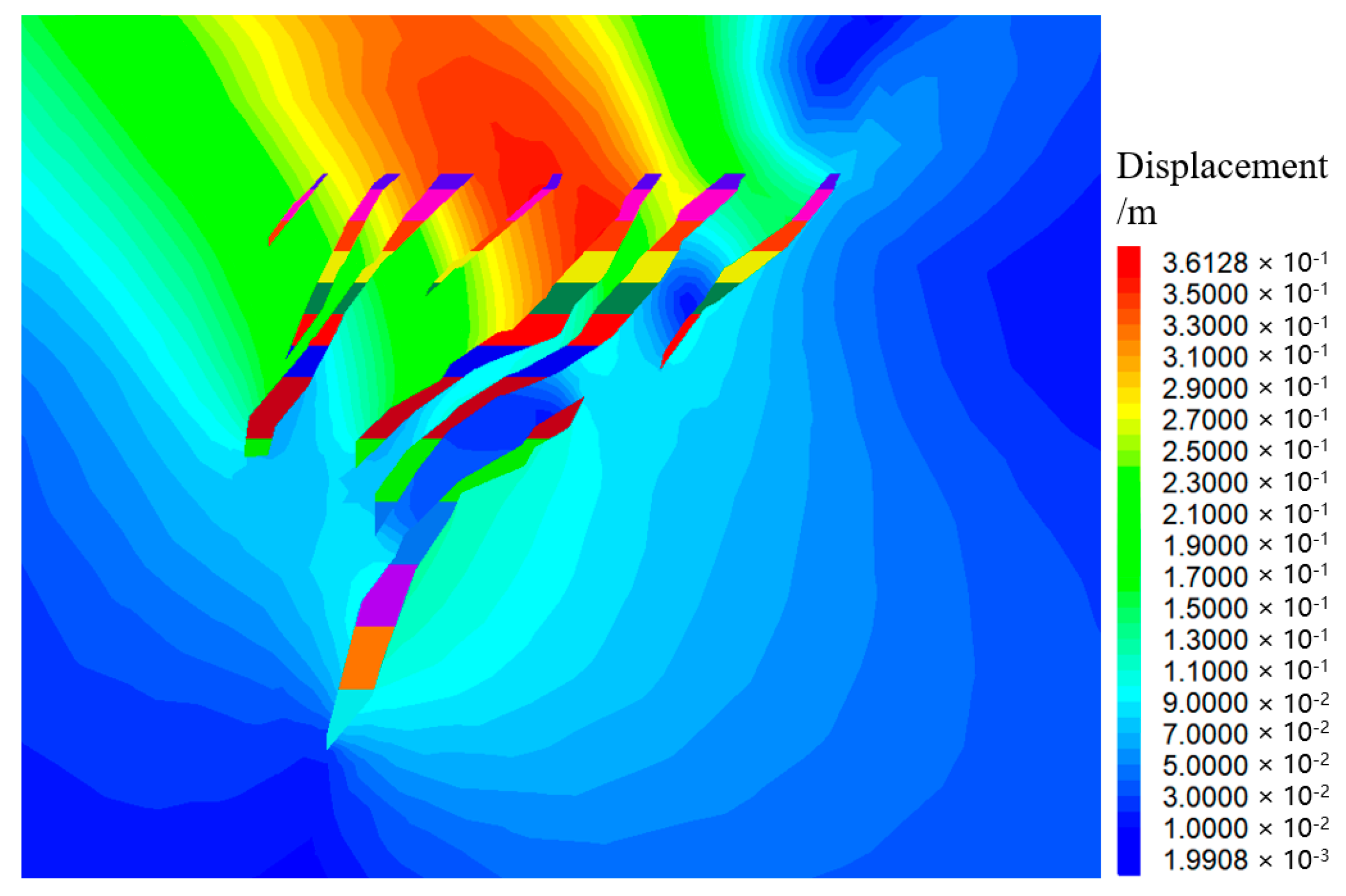
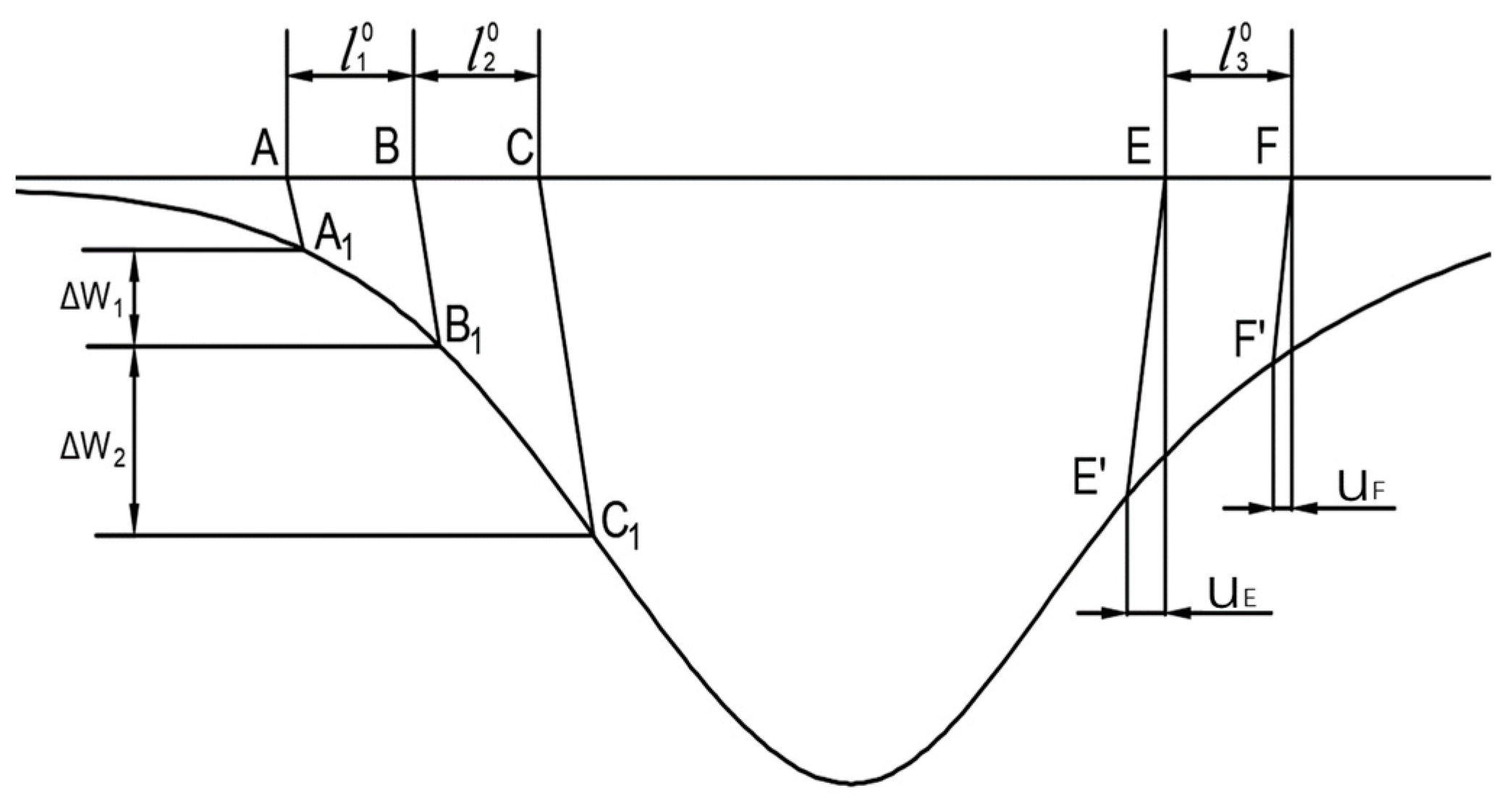
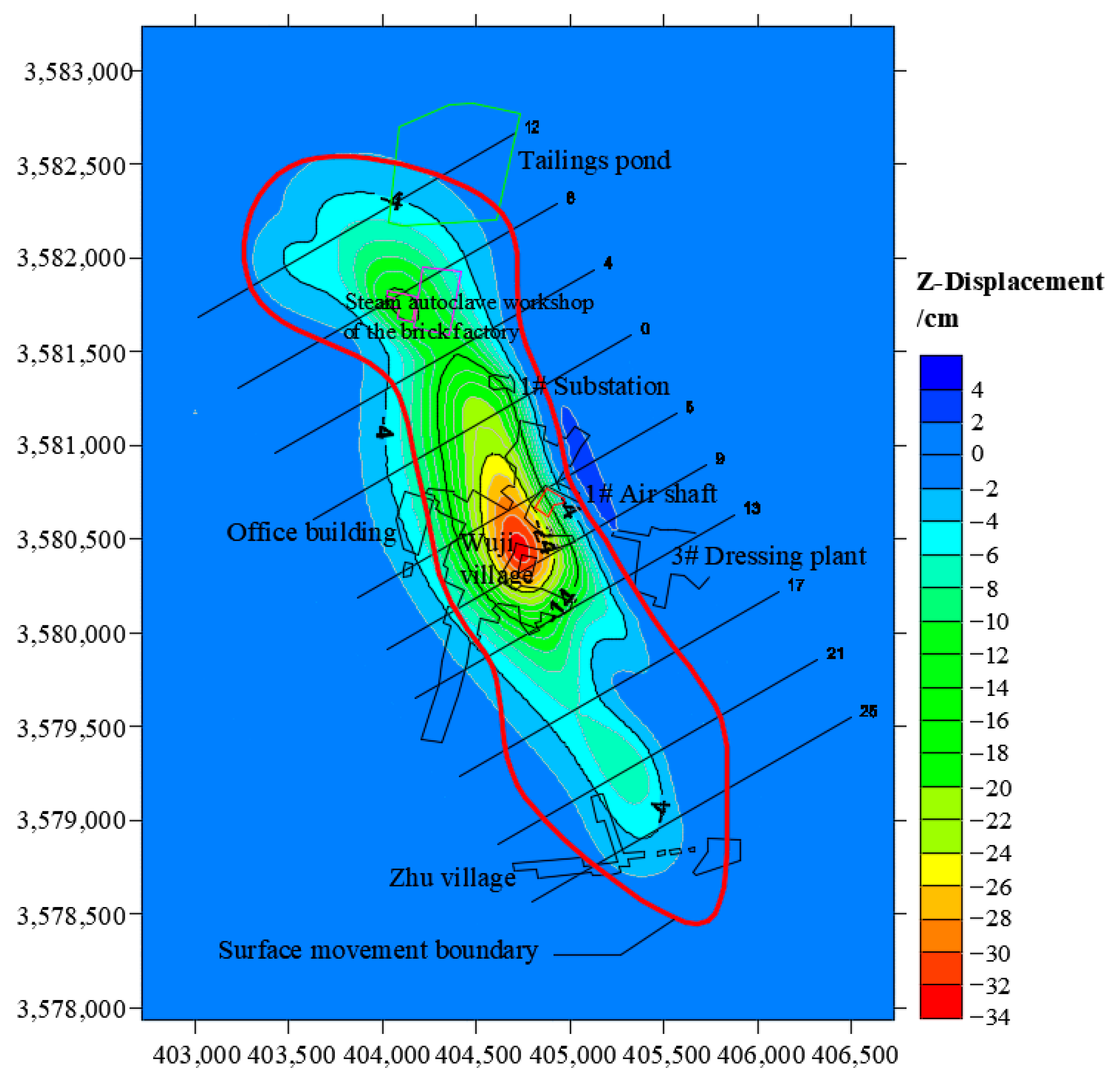



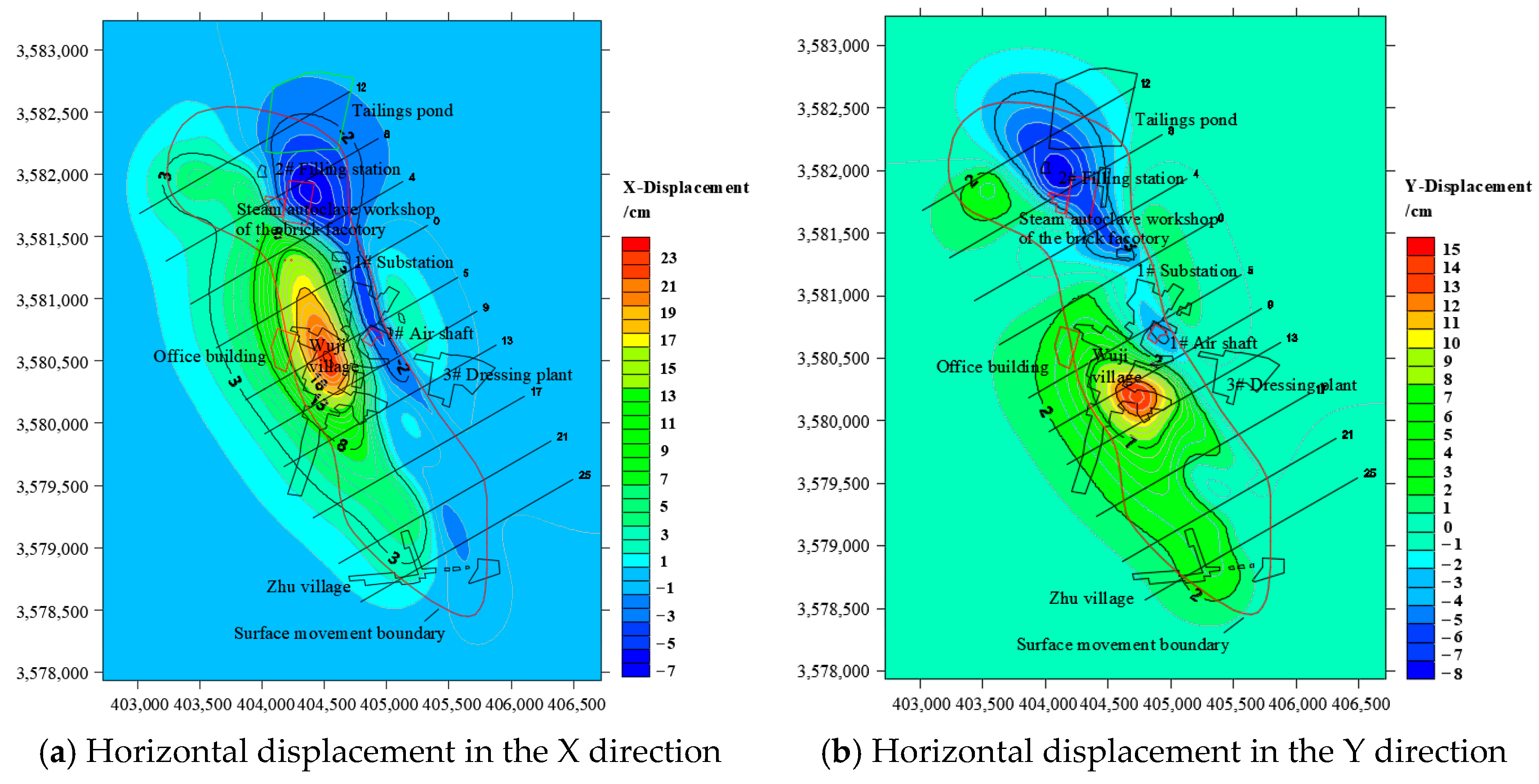

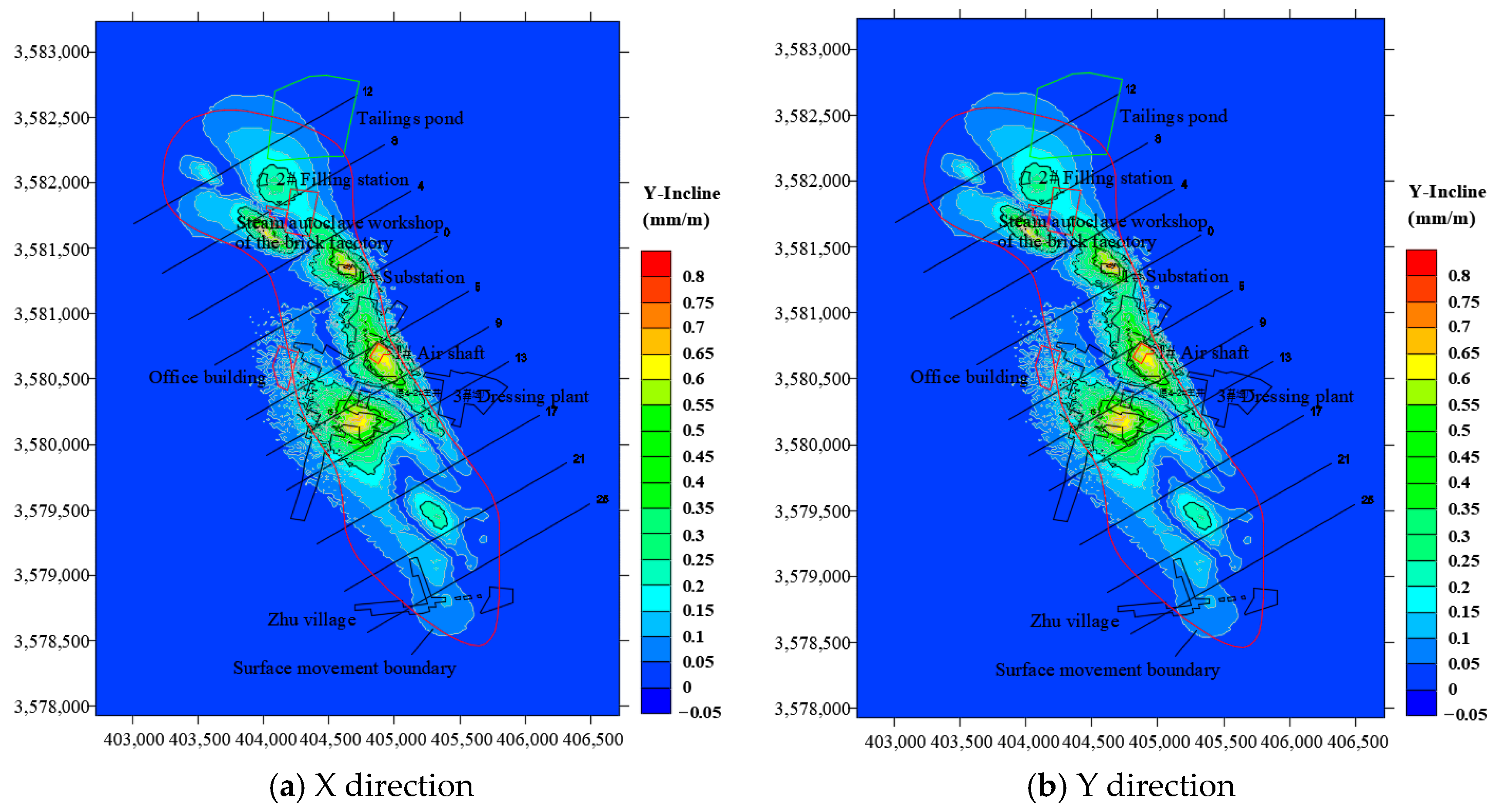


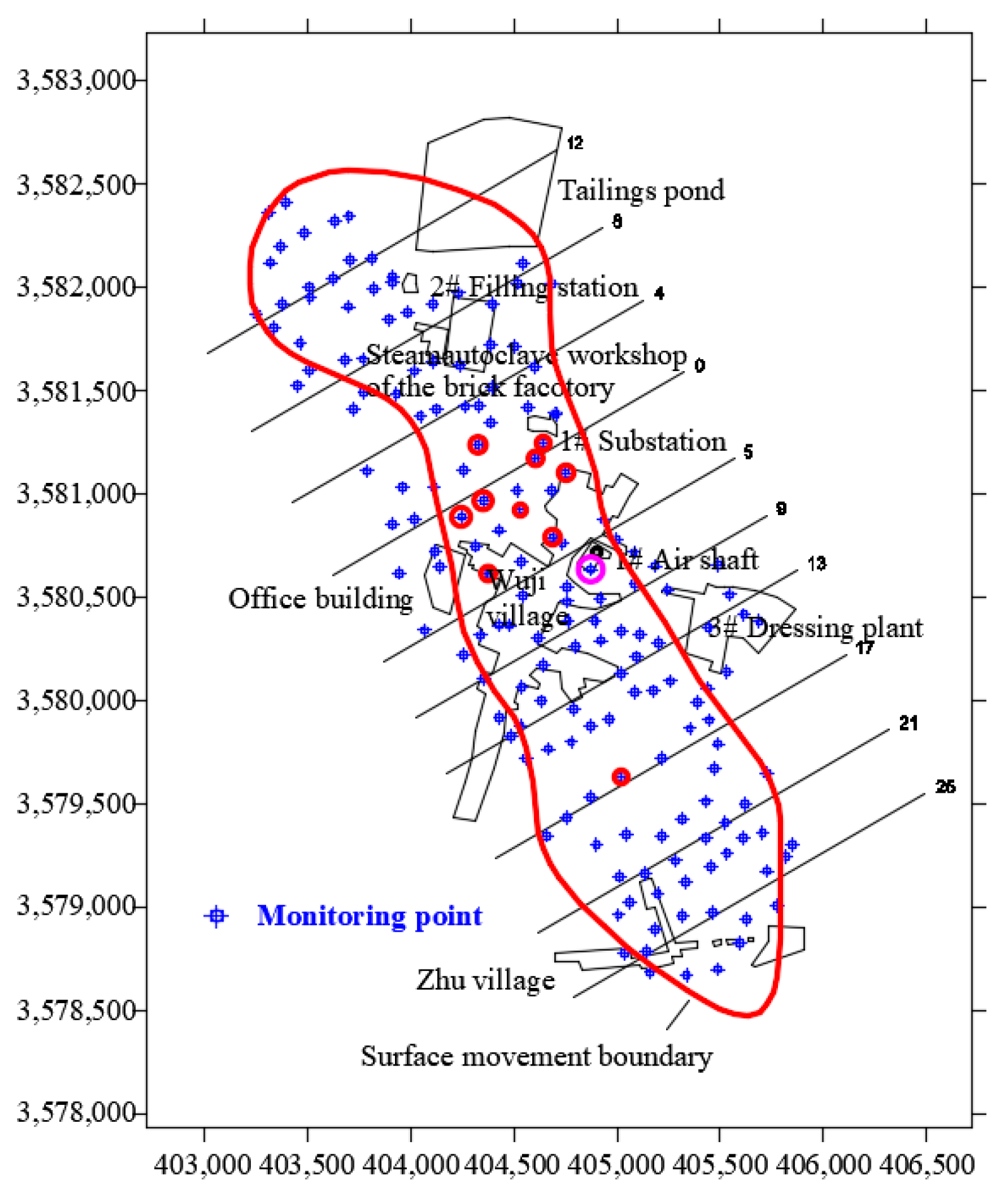
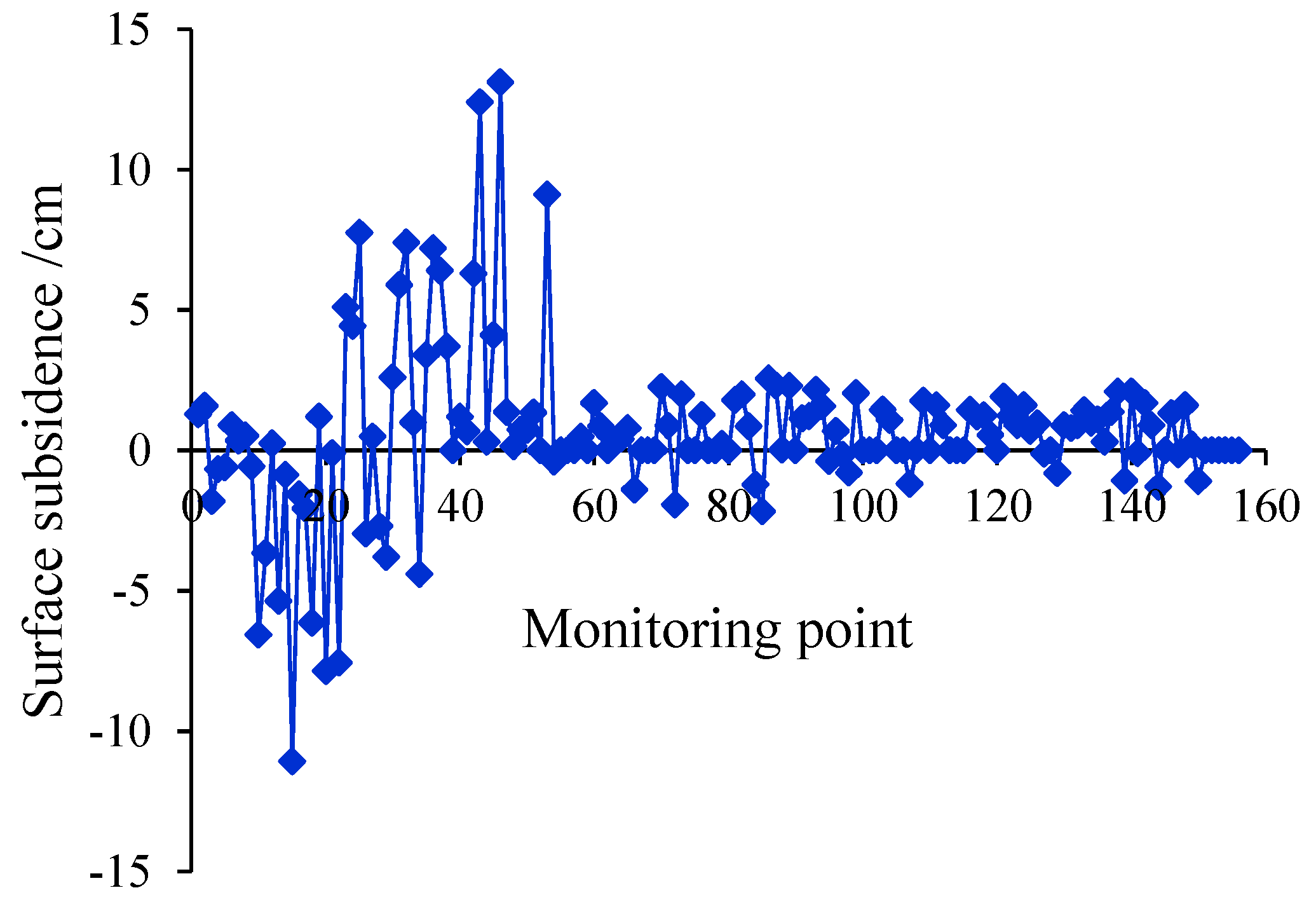


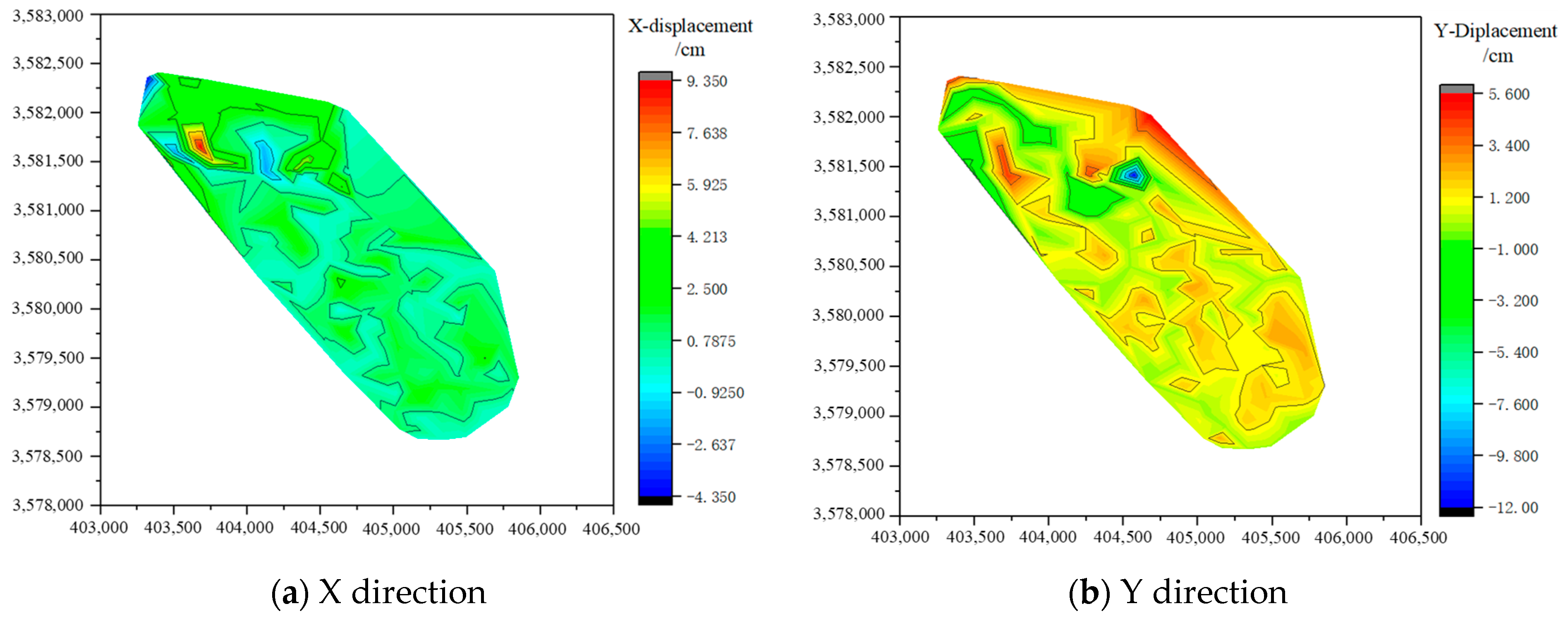
| No. | Content | Scheme I | Scheme II | Scheme III |
|---|---|---|---|---|
| 1 | Mining techniques | Simple | Simple | Simple |
| 2 | Backfilling techniques | Complex | Complex | Complex |
| 3 | Adaptability to ore body | Poor | Poor | Poor |
| 4 | Worker proficiency | Skilled | Requires training | Skilled |
| 5 | Production efficiency | General | High | High |
| 6 | Safe working conditions | Excellent | General | General |
| 7 | Mining equipment investment | High | High | High |
| 8 | Bulk fraction | High | High | High |
| 9 | Mining costs | 66 CNY/t | 64 CNY/t | 63 CNY/t |
| 10 | Recycling rate | High | Medium | Low |
| Category | Density (g/cm3) | Compressive Strength (MPa) | Tensile Strength (MPa) | Elastic Modulus (GPa) | Poisson Ratio μ | Cohesion (MPa) | Internal Friction Angle (°) |
|---|---|---|---|---|---|---|---|
| Surrounding rock | 2.84 | 124.56 | 7.62 | 60.23 | 0.23 | 16.60 | 43.85 |
| Ore body | 3.49 | 163.59 | 15.01 | 62.34 | 0.20 | 53.25 | 42.43 |
| Weathering zone | 2.68 | 50.47 | 5.55 | 34.97 | 0.26 | 11.08 | 44.36 |
| Quaternary | 1.92 | 1.65 | 0.17 | 0.23 | 0.35 | 0.03 | 25.00 |
| Backfilling body | 1.83 | 4.35 | 0.31 | 0.57 | 0.25 | 0.56 | 60.00 |
| Rock Formation | GSI Value | mi | mb | s | a |
|---|---|---|---|---|---|
| Ore body | 65 | 29 | 5.477 | 0.0094 | 0.502 |
| Surrounding rock | 45 | 29 | 2.113 | 0.0007 | 0.508 |
| Weathering zone | 20 | 12 | 0.689 | 0.0001 | 0.544 |
| Category | Compressive Strength (MPa) | Tensile Strength (MPa) | Deformation Modulus (GPa) | Poisson Ratio μ | Cohesion (MPa) | Internal Friction Angle (°) |
|---|---|---|---|---|---|---|
| Surrounding rock | 31.76 | 0.75 | 21.14 | 0.23 | 1.86 | 42.38 |
| Ore body | 45.92 | 2.76 | 25.12 | 0.20 | 3.72 | 41.76 |
| Weathering zone | 12.63 | 0.53 | 11.26 | 0.26 | 1.53 | 43.12 |
| Quaternary | 0.41 | 0.04 | 0.12 | 0.35 | 0.01 | 18.00 |
| Backfilling body | 4.35 | 0.31 | 0.57 | 0.25 | 0.56 | 20.00 |
| Buildings and Structures Protection Level | Inclination (mm × mm) | Curvature k (10−3/m) | Horizontal Deformation ε (mm × mm) |
|---|---|---|---|
| Ⅰ | ±3 | ±0.2 | ±2 |
| Ⅱ | ±6 | ±0.4 | ±4 |
| III | ±10 | ±0.6 | ±6 |
| IV | ±10 | ±0.6 | ±6 |
Disclaimer/Publisher’s Note: The statements, opinions and data contained in all publications are solely those of the individual author(s) and contributor(s) and not of MDPI and/or the editor(s). MDPI and/or the editor(s) disclaim responsibility for any injury to people or property resulting from any ideas, methods, instructions or products referred to in the content. |
© 2023 by the authors. Licensee MDPI, Basel, Switzerland. This article is an open access article distributed under the terms and conditions of the Creative Commons Attribution (CC BY) license (https://creativecommons.org/licenses/by/4.0/).
Share and Cite
Li, H.; Guo, Z.; Hua, X.; Dai, B.; Zeng, X.; Zhao, Y. Research on the Influence of Backfilling Mining in an Iron Mine with Complex Mining Conditions on the Stability of Surface Buildings. Sustainability 2023, 15, 14733. https://doi.org/10.3390/su152014733
Li H, Guo Z, Hua X, Dai B, Zeng X, Zhao Y. Research on the Influence of Backfilling Mining in an Iron Mine with Complex Mining Conditions on the Stability of Surface Buildings. Sustainability. 2023; 15(20):14733. https://doi.org/10.3390/su152014733
Chicago/Turabian StyleLi, Huaibin, Zhenpeng Guo, Xinzhu Hua, Bibo Dai, Xuemin Zeng, and Yuemao Zhao. 2023. "Research on the Influence of Backfilling Mining in an Iron Mine with Complex Mining Conditions on the Stability of Surface Buildings" Sustainability 15, no. 20: 14733. https://doi.org/10.3390/su152014733





